Weekly Topics/Archive
November 2013
|
Continuing from yesterday, I visit Kaijyusenji temple in Kamo Town.
My aim is to see a particular Kannon there.
Yes. It's a standing statue of Eleven-faced Kannon.
Today, I got on a Kizugawa City comunity bus for Okuhata at JR Kamo Station
west
exit.
The bus users might be very few. It wasn't a regular city bus but a microbus.
The number of the passengers was only three people that look like visitors
to Kaijyusenji
temple, except me.
The bus departure board shows that the bus on this route makes a round
trip once every
two hours but only five ones a day.
So I imagined what place the temple is located in.
The bus arrived at Kaijyusenji-kuchi bus stop after about ten minutes,
passing through
the remains of Kuni-kyo (temporarily the capital city during the Nara period)
and then
running on the narrow path in the fields on the way.
There is a small village at the foot of a mountain and in front of it spreads
an idyllic
rural landscape.
I walk from here to the temple.
According to the guide signs, I walk up the paved mountain road through
the village.
The leaflet from municipal tourism association shows that the temple is
only 1 Km
distant from the bus stop, but a uphill road with its hairpin curves continues.
I cried, “Maitta, Maitta”.
( “Maitta”, in Japanese, means “A little overwhelmed”.)
Since I saw the stone monument of “Kaijyusenji temple” on the way, I wondered
if
I might almost be there.
However there is a large signboard with a description of “800 m to go”.
Oh, really? There is a long way to go!
I saw a building that looks like the temple gate.
At any rate, it's an untended shabby building.
It wasn't the Sunmon gate but the Romon gate (two-storied gate).
When I walked for about 3 or 4 minutes after passing through the gate,
I could see
another gate beyond the steep stone steps on my left.
It was the true Sumon gate.
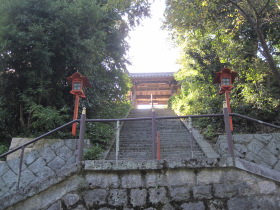
Sanmon gate (temple gate) of Kaijyusenji temple
|
|
|
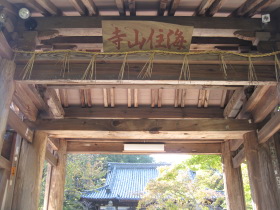
Hengaku
(temple's name tablet displayed on the gate) |
|
I headed to the temple ground passing through a detour route with gradual
slope.
I payed the entrance fee of 500 yen to enter the temple.
It's rather expensive!
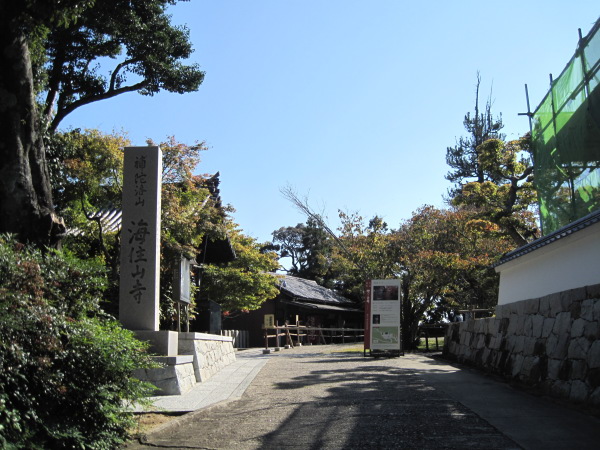
The entrance to the temple |
|
Now, let me introduce you about the temple.
According to the temple legend, Kaijyusenji temple started when the Emperor
Shomu,
who made a wish for the Great Buddha (Rushanabutsu statue), made Roben
Sojo
( the first betto of Todai-ji temple) build the temple here to pray for
the safe
construction of it, enshrined a statue of Eleven-faced Kannon Bosatsu and
named as
'Fujioyama Kannon-ji Temple' in 735, which is 6 years before construction of Kuni-kyo .
It was burnt down in 1137 and became extinct temporarily.
However, it was restored by Gedatsu Syonin Jokei of Kasagi-dera temple
and
the temple name also converted as the Fudarakusan Kaijyusenji temple.
It is said that the temple's appearance had been improved afterwards and
the number
of its sub-temples reached 57 at its peak.
For more detail on Kaijyusenji temple, please see the following picture
with photos.
 Picture / Pilgrimage to old temples / “Fudarakusan Kaijyusenji temple” Picture / Pilgrimage to old temples / “Fudarakusan Kaijyusenji temple”
I was so sweltering that I had the honor of seeing in a T-shirt.
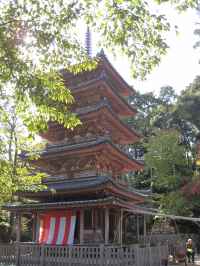
Five-soried pagoda
(National treasure,
Kamakura Period) |
|
First, I visited a five-storied pagoda in front of me.
Today the first story of the pagoda has been open to the public.
Inside it, statues of Shitenno (Important Property) are
enshrined north, south, east and west.
The first story does not have a center pillar but is supported
by the four pillars around the altar.
The structural characteristic is that the center pillar
extends from the ceiling of the first stoty.
As you may have already noticed while browsing the picture of the pagoda,
another one is that the lowermost roof is twofold and its bottom roof has
a sheet copper roofing Mokoshi (pent roof).
The five-storied pagoda with a Mokoshi stands only at this
temple and Horyu-ji temple.
The following is Hondo (main hall).

Hondo (Main hall) of Kaijyusenji temple |
|
“The Special Opening of Cultural Properties in Autumn” has been held.
I was able to see several wonderful temple's treasures.
Buddha statues I wanted to see are two different statues of standing Eleven-faced
Kannon Bosatsu.
One is the Kannon Bosatsu as the principal image in the main hall and the
other one is
the Kannon Bosatsu in Okunoin.
|
|
↑Standing statue of Eleven-faced Kannon
Bosatsu in Okunoin
(Wooden statue, 45.5cm tall, Heian Period,
important cultural property)
←Standing statue of Eleven-faced Kannon
Bosatsu in the main hall
(Wooden statue, 167.9cm tall, Heian Period,
important cultural property)
|
| Source; Reproduced from the Old Temples in Minamiyamashiro, 3rd Ed (Asukaen Inc.). |
Kannon in any temple has really soft features.
Although I may judge so with its state of preservation, I like the Kannon
in Okunoin
better.
Anyway, when I'm looking at the Kannon for a moment, I feel like my earthly desires
are wash out.
The following is a raigo-zu of an Eleven-faced Kannon (a picture drawn
on a board,
Muromachi Period).
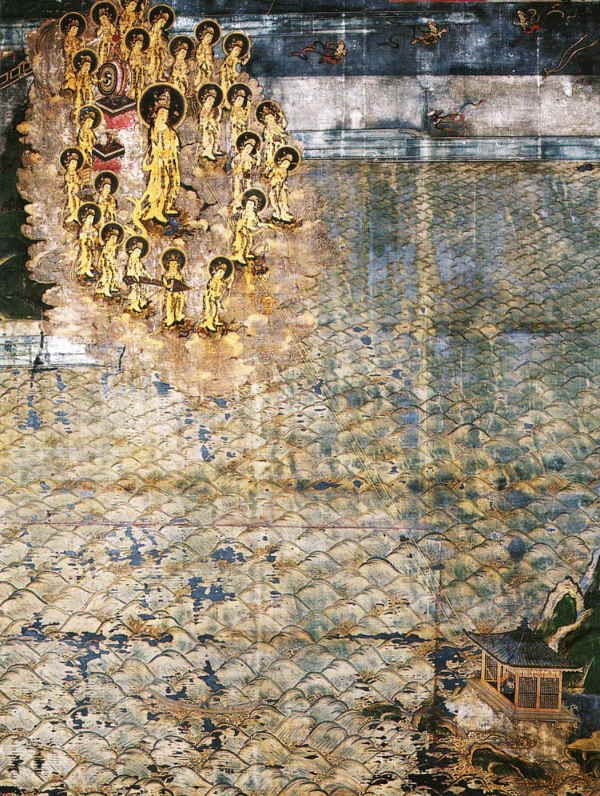
The raigo-zu of an Eleven-faced Kannon |
|
It depicts that the Eleven-faced Kannon on a cloud comes flying from Fudarakusan
on the upper left corner, which is the Pure Land of Kannon, and across a vast ocean,
comes down to the dead who claps his hands in prayer in the hermitage on
the lower
right corner.
I'm sure this painter strongly believed in Kannon.
It's because he couldn't paint imagine such a great composition, if not
so.
It's also very interesting that bodhisattivas around Kannon are playing
instruments.
It would communicate the world of belief as it was.
I heard, “The view from the hill behind the Hondo is great! ” and so came
there.
It overlooks the Kizu River and an area of Mikanohara in which “Kuni-kyo”,
a capital
in the Nara period, was located for only 3 years.
It was a little veiled in a haze but a woonderful landscape.
Next, I got into the Honbo ( main priest's residence ) and viewed its
garden.
If it was the foliage season, this photo might have been perfect for a
picture.
I left the temple because it was getting close to a time to get on the
bus .
It's especially because the bus is the only trafic in the area which is
run only once every
2 hours.
I feel less stressed because I walk downhill back.
The following is a view of Mikanohara I had on the way.
I took the 2:46pm bus at Kaijyusenji-guchi Bus stop to JR Kamo station.
I was very happy to meet wonderful Kannons today.
Photographing date ; October28, 2013
[Note] Kaijyusenji temple ; 海住山寺, departure board ; 出発時刻表示板
remains of Kuni-kyo ; 恭仁宮跡, idyllic rural landscape ; 長閑な田園風景
municipal tourism association ; 市観光協会, uphill road ; 坂道
hairpin curve ; 急カ−ブ, U字型カ−ブ, A little overwhelmed ; これはちょっと参った
stone monument of 〜 ; 〜の石碑, I'm almost there ; もうすぐ目的地に着く
wonder if 〜 ; 〜ではないかと思う, There is a long way to go. ; まだまだ先が長い
at any rate ; それにしても,untended ; 手入れされていない, shabby ; 粗末な
Romon gate (two-storied gate) ; 楼門, detour route ; 迂回路, temple legend ; 寺伝
Emperor Shomu ; 聖武天皇, make a wish for 〜 ; 〜を祈る(願う)
the Great Buddha (Rushanabutsu statue) ; 大仏(大盧舎那仏), Roben ; 良弁
the first betto (the head priest) ; 初代別当, Kuni-kyo ; 恭仁京
become extinct ; 廃絶する, restore ; 再興する, Gedatsu Syonin Jokei ; 解脱上人・貞慶
Fudarakusan Kaijyusenji temple ; 補陀洛山海住山寺, temple's appearance ; 寺観
sub-temple ; 塔頭, at one's peak ; 盛時に, have the honor of seeing ; 拝観する
north, south, east and west ; 東西南北に, lowermost ; 最下の, 最低の,twofold ; 二重の
sheet copper roofing ; 銅板葺きの, be veiled in a haze; もやに包まれる
overlook; を見渡せる, foliage season; 紅葉の季節, be perfect for a picture ; 絵になる
Okunoin ; 奥の院, state of preservation ; 保存状態
look at 〜 for a moment ; 〜をしばらくじっと見る, earthly desires ; 煩悩
raigo-zu ; 来迎図, depict ; (絵などで〜を)描写する, come flying ; 飛来する
Fudarakusan; 補陀洛山, Pure Land of Kannon ; 観音の浄土
clap one's hands in prayer ; 合掌する, hermitage ; 庵, 僧院, bodhisattiva ; 菩薩
get close to 〜; 〜に近づく,feel less stressed ; 気が楽だ
have a view of 〜 ; 〜の景色を眺める
Next, I visit Joruri-ji temple.
Joruri-ji temle is within walking distance of Gansen-ji temple.
But I'm going to wlk afterward.
I got on bus using a one-day ticket.
When I got off at Joruri-ji bus stop after 5 minute or so, I can see severl
Ocha-ya
(teahouse) and souvenior shops.
And when I get through the narrow path between them and follow a straight
approach,
I can see the main temple gate on the front.
It's small and simple gate.
When I passed through the gate to enter the temle ground, I could see a pond
surrounded by greenery.
I hear it's called Aziino-ike Pond or Houchi Pond or Enchi which means
garden with
a pond.
There is a main hall on the right (west) side of the pond and a three-storied
pagoda
on the left (east).
And now, as for the origin of Joruri-ji temple, according to the 14th-century
record
“Joruri-ji ruki no koto” which has been stored at this temple, it was
founded in 1047
by Gimyo Shonin, enshrining Yakushi Nyorai as its principal image.
It was a branch temple of Kofuku-ji Ichijo-in Temple from the Middle Ages
to Modern
Times.
But it converted to the Shingon Ritsu sect and became a branch temple of
Nara Sadai-ji
Temple during the turmoil of the anti-Buddhist movement at the beginning
of the Meiji
era.
The following is National Treasure of main hall (Nine Amida Statue hall).
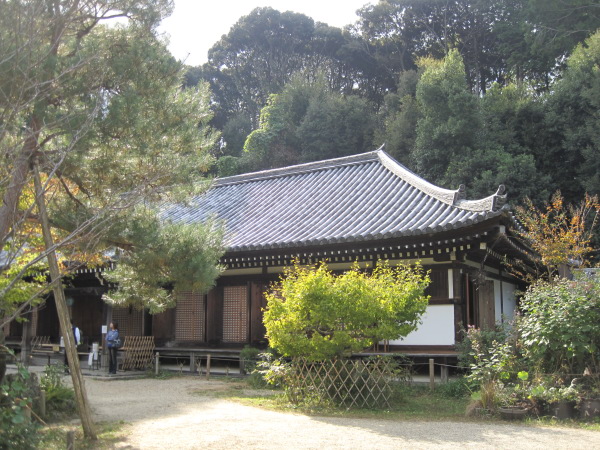
Main hall ( Nine Amida Statue hall (Heian Period) |
|
The hall faces onto the pond.
The view from here is wonderful, isn't it?
In the hall, nine seated statues of Amida Nyorai were enshrined laterally
in a row.
How spectacular they are!
 Nine seated statues of Amida Nyorai (Heian Period, National Treasure) Nine seated statues of Amida Nyorai (Heian Period, National Treasure)
Source; Reproduced from the Old Temples in Minamiyamashiro, 3rd Ed (Asukaen
Inc.). |
|
It enshrines Budda statues such as a standing statue of Kisshoten, a statue
of Fudo
Myoo with two youths, a standing statue of Jizo Bosatsu, Zikokuten and
Zocyoten of
a standing statue of Shitenno besides them.
This temple also has wonderful Buddha statues!
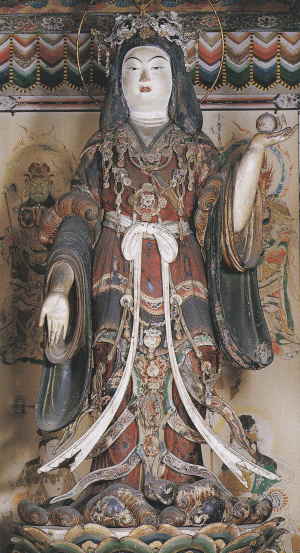
Standing statue of Kisshoten
(Kamakura Period, Important property)
<Wooden and colored, 50 cm tall> |
|
Please click on the picture to enlarge it.
↑ Standing statue of Jizo Bosatsu.
(Heian Period, Important property)
<Wooden and colored, 157 cm tall>
←↑Source; Reproduced from the Old Temples in Minamiyamashiro, 3rd Ed (Asukaen
Inc.).
|
I have seen a statue of Kisshoten in the textbook but never seen any actual
one.
As may be expected of a female statue, her clothes were colored beautifully.
I left the hall and then visited the three-storied pagoda on the other
side of Azino-ike Pond.
I hear that there is no pillar on the floor of the first layer and the central pillar
extends from the ceiling of the first layer.
Today a seated statue of Yakushi Nyorai (Important property) which is the principal
image of the pagoda was exposed to the public but it was completely invisible
because
an inside of the first layer had a poor light.
This is meaningless, isn't it?
The following is the view of main hall from here.
The leaves begin to turn a little yellow and red.
After visiting Joruri-ji temple for about an hour, I left it.
The area spanning from Joruri-ji temple to Gansen-ji temple.is called Tono
and known
as a village of stone Buddhist image.
I hear many Sekibutsu, Magaibutsu and Sekito dot in the valleys and along
narrow
mountain paths in this hilly area where there is rustic scenery to be seen.
Notes ; “Sekibutsu”, litterally means “Stone Buddha”, a Buddhist image made in
rock or stone.
“Magaibutsu” means a Buddha statue in cliffs and rocks.
“Sekito” means a stone pagoda.
This area might have been rich in granitic bedrocks.
So I decided to visit such stone Buddha while taking for awalk.
When I walked the paved road, I met “Yabunonaka Sanzon” soon.
Yabunonaka, in Japanese, means “inside of bush” and Sanzon means “three
image”.
Their names are “Amida”, “Jizo” and “Kannon”.
Please click on the small picture to enlarge it.
When I follow the sign, “Pilgrimage to stone Buddha”, the road changes
to
a mountainpath with a gradual slope.
Soon there is “Karasunotsubo” carved on the rock surface in the shade of luxuriant
leaves.
The path changes to a upward slope from here.
It's surrounded by cedars, cypresses and other broad-leaved trees and so
gloomy.
I met “Warai Hotoke” after walking for a little while.
“Warai Hotoke”, in Japanese, means “laughing or smiling Buddha”.
As its name, evry Buddha is smiling and so bring relief for visitors.
Next, I met “Mirokunotsuji”.
Since the surface of the rock was mossy, it was difficult to see its outline with the bare
eye.
Last, I met “Santai Jizo”.
The imges are of three children.
It was also difficult to see them because the shadow of the leaves dappled
the rock
surface.
I found myself being covered in sweat.
This route was on the uphill.
Looking back, the reversed route is suitable for the elderly.
I got to a mountain village in which Gansen-ji temle is located.
Persimmon trees bore a lot of fruit.
Today I enjoyed the excellent Buddhist image fully again.
Tommorow I'm going to visit Kaijyusenji temple in the same town, Kamo Town.
For more detail on Zyoruri-ji temple, please see the following picture.
 Picture / Pilgrimage to old temples / “Odawarasan Joruri-ji temple” Picture / Pilgrimage to old temples / “Odawarasan Joruri-ji temple”
Photographing date ; October.27, 2013
To be continued Weekly Topics / No.203−Oct 28, 2013 / Weekly Topics / No.203−Oct 28, 2013 /
“Visiting Kannons in Minami Yamashiro (Part4)
−A standing statue of the Eleven-faced Kannon of Kaijyusenji temple−”
(Coming soon. Don't miss it!)
[Note] within walking distance of 〜; 〜から歩いて行ける距離
afterward ; 後ほど,get through ;通り抜ける,follow an approach;参道を進む
Ocha-ya(teahouse);お茶屋, surrounded by greenery;緑に囲まれた
Aziino-ke Pond;阿字池, be stored at;に保管されている, Gimyo Shonin;義明上人
Joruri-ji ruki no koto;浄瑠璃寺流記事(じょうるりじるきのこと), Yakushi Nyorai ; 薬師如来
from the Middle Ages to Modern Times;中世から近世にかけて,branch temple;末寺
turmoil;混乱,騒動,anti-Buddhist movement;廃仏毀釈運動
the Nine Amida Statue hall;九体阿弥陀堂, face onto 〜;〜に面している(家などが)
in a row;一列に(並んで), besides 〜;〜の他に, 〜に加えて
as may be expected of 〜;さすがに〜だけあって, central pillar;心柱
expose to the public;開帳する, be completely invisible;全く見えない
meaningless;無意味な, The leaves turn yellow and red.;紅葉する
Magaibutsu (Buddha statue in cliffs and rocks);磨崖仏
rustic landscape;ひなびた景色, granitic bedrock;花崗岩の岩盤
follow the sign;道標に従って歩く, in the shade of 〜;〜の影で,luxuriant;青々と茂った
upward slope;上り坂, cedar;杉, cypress;檜, broad-leaved tree;広葉樹
bring relief for 〜;〜を癒す, mossy;苔むした, with the bare eye;肉眼で
dapple;をまだらにする, find oneself doing;気が付くと〜している
be covered in sweat;汗ばむ, Looking back;今思えば, 思い返すと
persimmon tree;柿の木, bear a lot of fruit;果実がたわわに実る
Japanese Diary / No.570−2013.10.27 / 「南山城の古寺巡り(その1)・浄瑠璃寺」 Diary / No.570−2013.10.27 / 「南山城の古寺巡り(その1)・浄瑠璃寺」
 TOPペ−ジへ戻る TOPペ−ジへ戻る
|
|